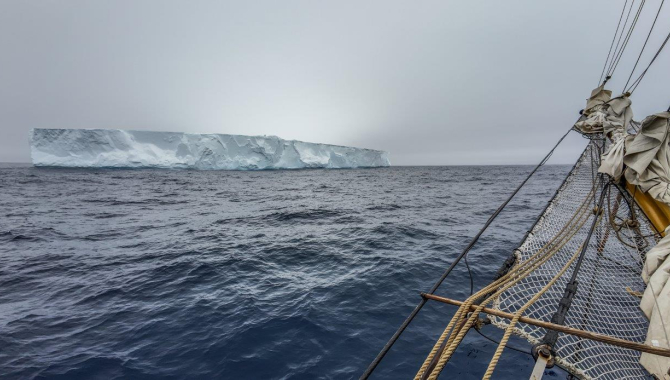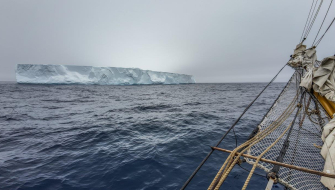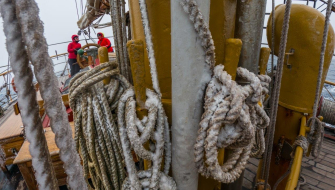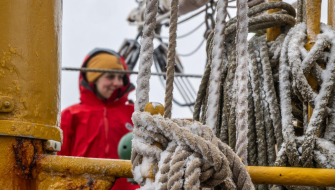Motoring and motorsailing approaching Antarctica.

Thick fog during the night, reduced visibility that brought us closer to the sea ice and to follow its edge for a few hours.

With lighter winds, now veering, now backing a bit, it has been another day combining the pure motoring with motorsailing under staysails.
The air is moist, the rig gets wet, and when the temperature lowers under the freezing point, ice grows over standing and running rigging again. As the following hours had been cold too, it remains frozen for the whole day.
Foggy and misty conditions broke up in better visibility moments, then some of the icebergs around become visible. A large tabular stands close to our track. First, a glow is seen at the distance, getting closer we can see that it is the light reflecting over its flat top in comparison with the surrounding dark ocean. Icebergs of considerable size can change the characteristics of the environment surrounding them. The air atop is cold, the light reflects better on them, they change the evaporation rates in contrast with the waters around. Often a cloud grows above them. As we just see their tip and most of their mass and volume is underwater, they can have an effect too on the general currents. Steep-sided and tall, they can offer too some shelter from winds on their lee side, though growlers and bergy bits broken up from their icy walls also drift that way.
Below water, the depths of the deep ocean get shallower here. From over a couple of thousand meters, they rise up to the order of just several hundred.

A look at the chart reveals that our track just runs over a long submarine mountain range. It was during the scientific Scottish Antarctic Expedition led by William Bruce during the years 1902-1904 that this oceanic floor feature was discovered. Their soundings would reveal a sea floor ridge, emerging above water in various islands in a continuous way starting at Cape Horn, stretching to South Georgia, bending southeast to the South Sandwich Islands and then turning westwards towards the South Orkneys, and finally to the tip of the Antarctic Peninsula.
It forms a discontinuous link between South America and Antarctica, and can be considered a continuation of the Andes. Islands and relatively shallower waters that have an effect in the area over the Antarctic Circumpolar Current, that after squeezing through the Drake Passage, its flow finds here these obstacles on its way along the globe at the southern high latitudes.
A geological and geographical characteristic of these waters now known as the Scotia Arc, after Bruce’s expedition ship.
